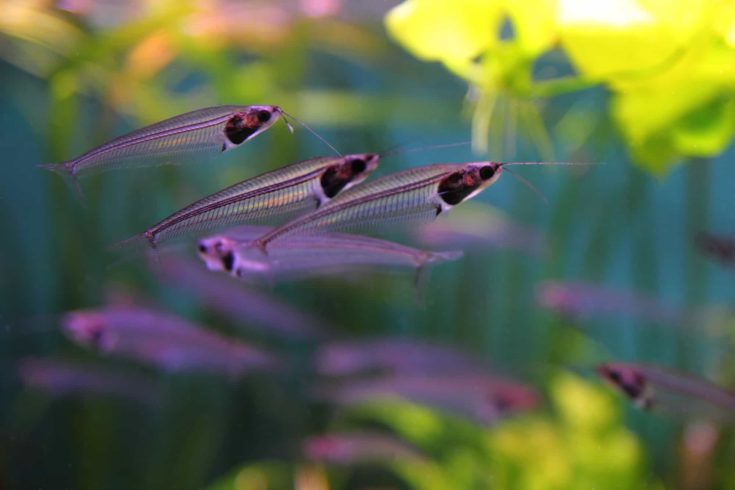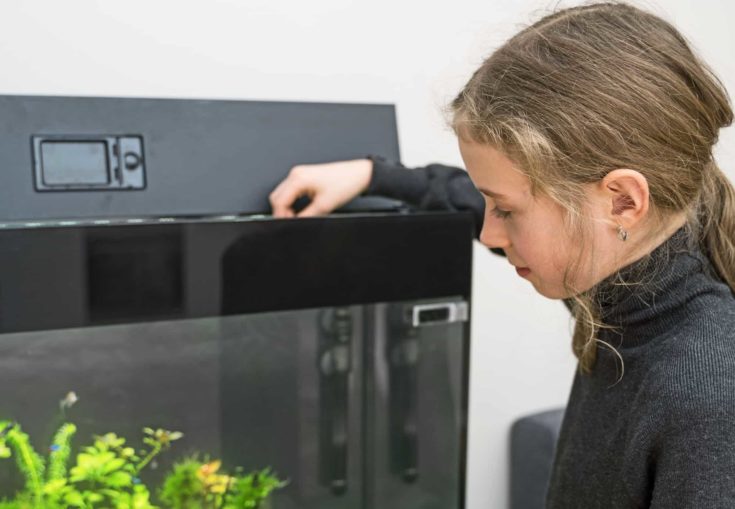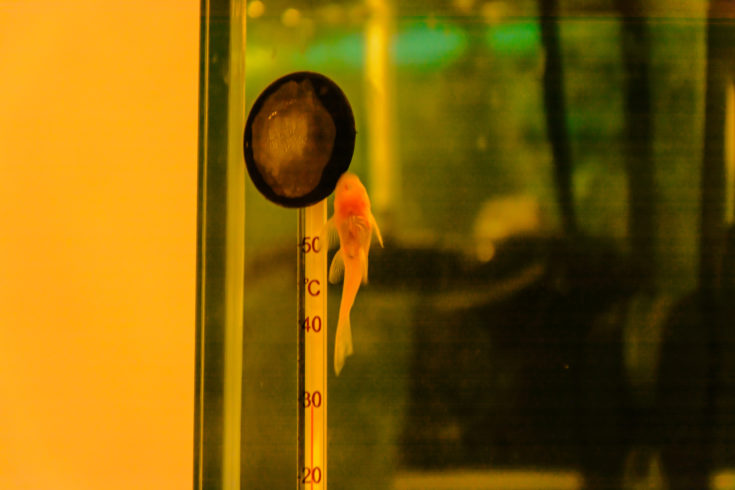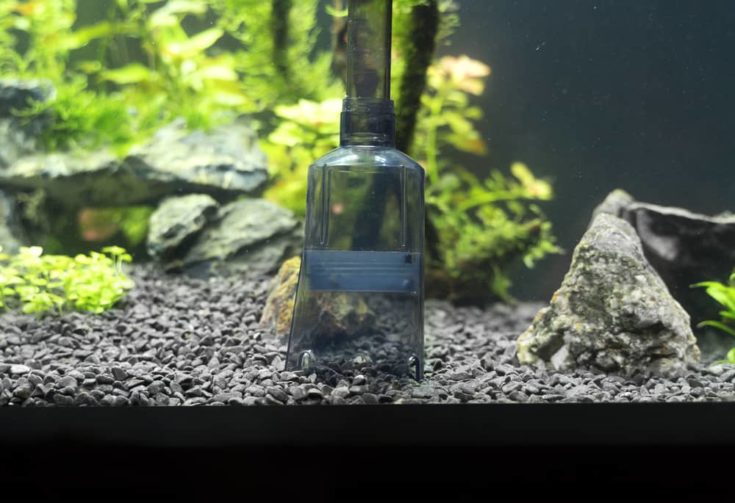Starting an aquarium for the first time can be exciting but also intimidating. There’s so much information on the internet that it can be challenging for novice fish keepers to know where to start when setting up a tank. I’ve put together these tips on aquarium care for beginners so you can quickly and easily learn how to care for freshwater fish!
Aquarium Basics: What Do Fish Need To Survive And Thrive?

Have you been dreaming of starting a fish tank, but have held off because their care and maintenance seems so complicated? Don’t get bogged down in an information overload! With these 15 simple tips, you can get your tank up and running in no time and have a healthy and thriving aquatic community!
Before we dive into the list, let’s cover the three critical factors that determine the health of your aquarium and the fish inside. All of the tips below trace back these key elements. By focusing on the three basic necessities, you can avoid most major aquarium problems and have a healthy tank of fish!
- Design the right habitat for your fish in terms of capacity, temperature, filtration, and decor.
- Provide an appropriate and high-quality diet for your tank’s occupants.
- Perform regular aquarium maintenance on your equipment and tank.
Tips For Starting A New Aquarium
The first thing you’ll have to do is decide on the type of fish or animals you’d like to keep in your aquarium. It’s much easier for beginning fish keepers to build a tank around the needs of a specific species. So choose your focus fish or invertebrate and avoid wasting time and money on a set-up that isn’t adequate for your pets!
Pick The Right Type Of Aquarium And Set-up

The capacity of your aquarium determines the type of fish you can keep, since each species has an ideal amount of room they need to swim and explore. For instance, while you can keep a male Betta in a small 5-gallon tank you’ll need at least 20-gallons if you’d like a group of fancy goldfish.
Nano tanks are a popular option for novices, but can also be more challenging to maintain than larger aquariums. I recommend getting the biggest capacity tank you can to make things easier. Then equip it with the right type of filter, heater, and substrate for your focus fish.
Choose Compatible Tank Mates For Your Community
The good thing about building an aquarium around a focus species is it makes it easy to determine what types of tank mates are compatible and suited to your setup. If you stick with animals that are known to get along with your focus species you’ll avoid problems with aggression and should have a peaceful community tank.
Avoid Overcrowding Your Tank
Fish experience stress when they don’t have room to swim and explore. The general rule of thumb is to allow 1-gallon of capacity for every inch of fish in the tank, so a fish that reaches 6-inches in length will need at least 6-gallons of water. Active swimmers like freshwater sharks or common goldfish may need even more room.
How To Feed Your Fish For Optimal Health

Balanced nutrition is an important part of having a healthy aquatic community. Most freshwater fish are either vegetarian and eat algae and plant materials, or are omnivores and eat plants and animals. It’s easy to make mistakes when it comes to feeding fish, so here are my top 4 tips on aquatic nutrition!
Feed A Variety Of Commercial Diets And Treat Foods
Choose a high-quality commercial fish food as your primary diet and rotate types or brands to add variety, and provide your fish with a range of treat foods as well.
- Pick diets suitable for your animal’s feeding behaviors. Fish that swim at the top and middle of the tank often prefer floating flakes or pellets, while bottom-feeders benefit from sinking pellets and wafer diets.
- Substitute fresh/frozen/freeze-dried treats in place of their regular diet 2 to 3 meals a week to ensure your fish are getting a balanced diet.
Avoid Overfeeding
It’s very easy to add too much food to your aquarium, and that causes problems with your water quality. Overweight fish are also much more likely to have health problems and a reduced lifespan. Unless you’re raising young fish fry, you don’t need to feed your aquarium more than once a day.

To avoid overfeeding, only add as much food as the community can consume in about 2 to 3 minutes and remove any leftovers promptly so they don’t start to decay. Most fish benefit from a regular fast-day once a week as well. If you’re using food to train or play with your fish, then feed them less at their regular meal times.
Don’t Buy Old, Dusty Jars Of Fish Food
Commercial diets are made from seafood, algae, and seaweed and may become rancid and stale over time. If you’re buying food at a store, avoid grabbing old jars that have been sitting on the shelf for years and always check the expiration dates. Toss jars once they’ve been opened for 6 months or any diets that have expired.
Avoid Buying Fish Food In Bulk
Once a container of fish food is opened, exposure to the light and air degrades the nutrients and causes it to spoil. It’s better and more cost-effective to buy small amounts of food rather than a huge jar that will spoil or expire before you can use it all. I only keep about a month’s worth of food on hand at a time for my tanks.
Tips For Maintaining Your Fish Tank
Aquarium maintenance can seem like a complicated topic, but it’s actually fairly straightforward. The easiest way to deal with maintenance is to get into a routine and have a list of daily, weekly, and monthly tasks you perform on schedule. To keep a healthy tank of fish:
Monitor The Temperature And Check The Filter Daily

Make it a habit to take a quick peek at your thermometer and look over your heater and filter once a day to be sure all is working as it should be. If your temperature drops or your filter pad gets clogged you don’t want to discover the problem a week later when you start losing fish or have a puddle on your floor!
Test Your Water Quality
I recommend testing your aquarium’s water once a week for the first couple of months and then once a month once it’s established. If the pH or ammonia levels suddenly shift you’ll catch the problem before your fish show signs of stress. You can get inexpensive water testing kits with a variety of test strips at most aquatic stores.
Make Changes Slowly And Gradually
If you do suddenly notice a problem with your aquarium, either through observation or as the result of a test, don’t panic! Patiently make adjustments to your tank and change the parameters slowly and gradually. Most fish can survive in a range of water conditions but become stressed if things shift quickly.
Do Partial Water Changes On A Regular Schedule
There are no hard-and-fast rules on how often or how much water you should change in your tank. It depends on factors such as the capacity of the tank, the type of filtration system, how many fish and how often they are fed, etc. Small tanks may need weekly water changes, while larger tanks may only need them once a month.

- A typical water change removes and replaces about 25% of the water in the aquarium and can be done as often as every day if needed.
- If you have an algae outbreak or sick fish, you can change up to 50% of the water in the tank every 24-hours but don’t remove more than that at a time, or it could cause further stress to your fish.
Remove Algae Monthly
Algae can become troublesome if it takes over your entire tank, but having little algae in your aquarium isn’t a problem. In fact, algae is a great source of food for many aquatic species, and some shrimp and fish can starve if you remove it all. Remove problem algae once a month by wiping it off your tank and equipment.
Don’t Overclean Your Tank

When cleaning your fish tank, it’s a good idea to gently siphon debris from the gravel and remove algae from your tank’s sides, but don’t go overboard. A fish tank is not a sterile environment. The good bacteria living in your substrate and filter help keep your ammonia levels in check, so don’t clean too vigorously or your tank could crash.
Observe Your Fish Regularly
The best way to head off problems is to observe your healthy fish so you can spot the signs of trouble as soon as they show up.
- Keep an eye on your fish’s activity levels and appetite, and make notes of any fish that aren’t acting, swimming, or eating normally.
- Also, monitor their scale color and overall appearance.
- Stressed or sick fish often appear faded or dull in color.
- Look for injuries or signs of illness like fin rot or white spot disease.
If you spot a problem with your fish:

- Test your water quality and make any necessary adjustments to your tank.
- Isolate sick fish in a hospital tank apart from the healthy animals for treatment.
- Or, if your entire tank is showing signs of illness, diagnose and treat the entire aquarium.
- Look up specific treatment protocols in a good fish care guide and be sure to adjust your equipment as needed while medicating the tank.
Be Careful With Copper-Based Medications
Oftentimes, you can heal a sick fish without using antibiotics or other medications by doing water changes, adjusting your light cycle, or increasing or decreasing the water temperature. But sometimes these methods fail to fix the problem and you may have to resort to using water-based medications. They should be your last resort, however.
Many freshwater fish and nearly all snails and shrimp are sensitive to copper, and medications that contain copper could poison your tank and kill these sensitive species. Never use medication unless you’ve confirmed that it doesn’t contain ingredients toxic to the species you’re keeping in your tank.
Conclusion
I hope you’ve enjoyed these basic tips for aquarium care, and we’d love to hear your feedback in the comments. Or you can come join our social media pages and see what other folks are doing with their tanks! If you follow the tips and advice in this article, you can head off most aquatic problems and easily maintain a beautiful tank!


Thank you for the very useful article, I have applied these ways and feel very effective